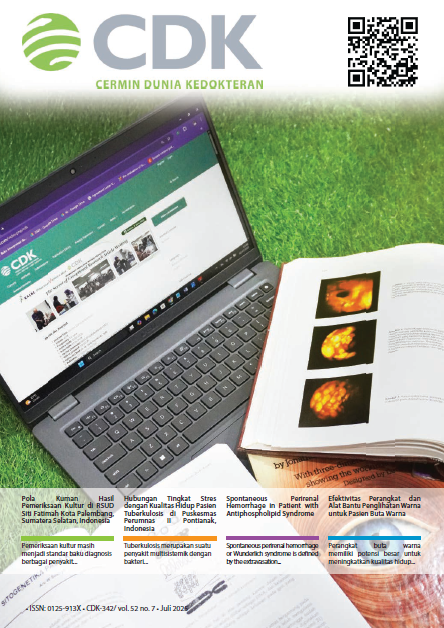Unidentified Extraperitoneal Bladder Trauma: A Case with Normal Cystography
Case Report
DOI:
https://doi.org/10.55175/cdk.v52i7.1372Keywords:
Bladder trauma, cystography, foreign bodyAbstract
Introduction: Bladder trauma is the second most commonly injured organ in the genitourinary system after the kidney. The injury can be caused by a variety of mechanisms, including blunt trauma, penetrating trauma, and iatrogenic procedures. Case: A 21-year-old male with multiple injuries following a motorbike accident. Upon examination, a foreign body was detected in the right thigh. A CT scan revealed a metal rod impaled in the patient’s bladder without any contrast leakage. The patient was planned for foreign body removal and bladder repair. During the removal, bladder leakage was detected. The patient underwent foreign body removal and bladder repair. Discussion: This case underscores the importance of considering bladder injury in trauma patients, even in the absence of classic clinical signs such as haematuria. It also highlights the potential limitations of initial imaging techniques like cystography in detecting bladder injuries when foreign bodies are present. Conclusion: This case emphasizes the importance of maintaining a high index of suspicion and considering intraoperative exploration or additional diagnostic methods when imaging findings are inconclusive. Revising the diagnostic protocol for trauma patients with suspected bladder injury, especially if a foreign body is present, is essential to avoid missed diagnoses and improve patient outcomes.
Downloads
References
Mahat Y, Leong JY, Chung PH. A contemporary review of adult bladder trauma. J Inj Violence Res 2019;11(2):101-06. DOI: 10.5249/jivr.v11i2.1069.
Abouzead L, Leone C, Shaikh S, Aniukwu J. Traumatic extraperitoneal bladder rupture in the absence of pelvic fracture in a patient with pelvic organ prolapse: A case report and review of the literature. Int J Surg Case Rep 2022;95:107150. DOI: 10.1016/j.ijscr.2022.107150.
Kuo YC, Chien CY, Li PH, Hsu TA, Fu CY, Bajani F, et al. Validation of the twenty-four-hour threshold for bladder repair: Impact on infection rates using the national trauma data bank. World J Surg 2023;47(12):3116-23. DOI: 10.1007/s00268-023-07224-w.
Anderson RE, Keihani S, Moses RA, Nocera AP, Selph JP, Becerra CMC, et al. Current management of extraperitoneal bladder injuries: Results from the multi-institutional genito-urinary trauma study (MiGUTS). J Urol 2020;204(3):538-44. DOI: 10.1097/JU.0000000000001075.
Abd-erRazik MA, Abdel Hamid MA, El-Shinawi M, Hirshon JM, El-Hariri HM, El-Setouhy M. Combination of focused assessment with sonography for trauma (fast) scan and detection of hematuria to exclude intra-abdominal injuries following blunt abdominal trauma. Cureus 2023;15(2):e34736. DOI: 10.7759/cureus.34736.
Odoemene CA, Onuh CA. Foreign bodies in the urinary bladder – Case series. J West African Coll Surg 2017;7(3):124-36. PMID: 30525007.
Morey AF, Simhan J. Genital and lower urinary tract trauma. In: Partin AW. Dmoehowski RR, Kavoussi LR, et al, editors. Campbell-Walsh urology. 12th Ed. Philadelphia: Saunders; 2022. pp. 3048-51.
Lu HJ, Lee EH, Alerhand S. Delayed iatrogenic bladder rupture diagnosed by POCUS in the emergency department. POCUS J 2023;8(1):38-42. DOI: 10.24908/pocus.v8i1.16239.
Wongwaisayawan S, Krishna S, Sheikh A, Kaewlai R, Schieda N. Imaging spectrum of traumatic urinary bladder and urethral injuries. Abdom Radiol (NY) 2021;46(2):681-91. DOI: 10.1007/s00261-020-02679-0.
Lee MJ, Wright A, Cline M, Mazza MB, Alves T, Chong S. Pelvic fractures and associated genitourinary and vascular injuries: A multisystem review of pelvic trauma. Am J Roentgenol 2019;213(6):1297-306. DOI: 10.2214/AJR.18.21050.
Stern N, Pignanelli M, Welk B. The management of an extraperitoneal bladder injury associated with a pelvic fracture. Can Urol Assoc J 2019;13(6 Suppl4):S56-S60. DOI: 10.5489/cuaj.5930.
Reddy D, Laher AE, Moeng M, Adam A. Bladder trauma: A guideline of the guidelines. BJU Int 2024;133(4):365-74. DOI: 10.1111/bju.16236.
Diniz ALL, Resende Jr JAD, Andrade Jr CMd, Brandao AC, Gasparoni Jr MP, Favorito LA. Urological knowledge and tools applied to diagnosis and surgery in deep infiltrating endometriosis – A narrative review. Internat Braz J Urol. 2023;49(5):564-79. DOI: 10.1590/s1677-5538.ibju.2023.9907.
Ward H, Nazim M, Jiang R. Extraperitoneal bladder injury with extensive contrast extravasation – A case report. Urol Case Rep 2022;42:102024. DOI: 10.1016/j.eucr.2022.102024.
Agha RA, Borrelli MR, Farwana R, Koshy K, Fowler AJ, Orgill DP, et al. The SCARE 2018 statement: Updating consensus Surgical CAse REport (SCARE) guidelines. Int J Surg 2018;60:132-36. DOI: 10.1016/j.ijsu.2018.10.028.
Downloads
Published
How to Cite
Issue
Section
License
Copyright (c) 2025 Reza Affandi, Yufi Aulia Azmi, Soetojo Wirjopranoto

This work is licensed under a Creative Commons Attribution-NonCommercial 4.0 International License.





















